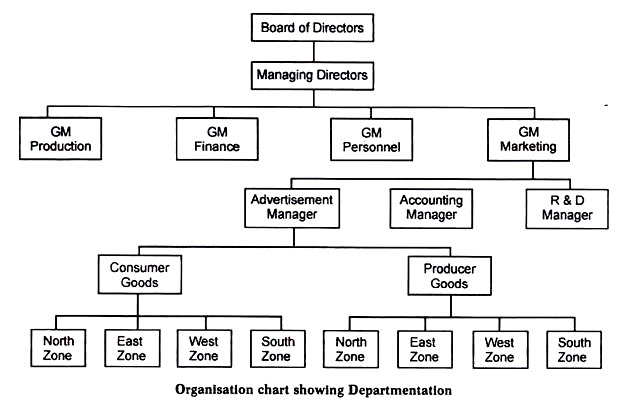This article throws light upon the eight main factors to be considered while choosing a basis of departmentation. The factors are: 1. Work and Process 2. Specialisation 3. Capabilities of Workers 4. Technology 5. Competitors’ Approach 6. Co-Ordination and Control 7. Environment 8. Optimum Utilisation of Resources.
Factor # 1. Work and Process:
Departments should be created on the basis of work performed in the organisation and the processes involved in carrying out that work. If the work is simple, functional structure can be the basis of departmentation. However, if the work involves a number of processes, process departments is the suitable form of departmentation.
Factor # 2. Specialisation:
Whatever the basis of departmentation, it should group organisational activities in a manner that leads to specialisation. Specialisation leads to economy of efforts, time and money and effectively contributes to organisational objectives. However, over specialisation should be avoided as it creates water-light compartments amongst departments and complicates the process of coordination.
Factor # 3. Capabilities of Workers:
Besides technical aspects of the job, departmentation should also consider abilities of the workers who perform those jobs. Human values, cultures, beliefs and attitudes play important role in creating departments in the organisation. Workers contribute to organisational goals in the hope to achieve personal goals through them.
If workers are satisfied with the basis of departmentation (or the organisation structure), their commitment to organisation increases and the goals are more likely to be achieved effectively.
Factor # 4. Technology:
Technological factors are important determinants that affect departmentation. The basis of departmentation should be such that it helps to produce goods at minimum cost and contribute to organisational goals within the technological framework of the company.
Where different technology is required for different products, the suitable form is product departmentation and where the same product goes through different processes, process departmentation is the suitable form of organisation structure.
Factor # 5. Competitors’ Approach:
Two or more firms selling the same product to same customers in same geographical areas should preferably have the common basis of departmentation to remain competitive in the market.
Factor # 6. Co-Ordination and Control:
Managers coordinate the activities of various departments to ensure their optimum contribution to organisational goals. Control by measurement of actual performance with planned performance is also necessary. The suitable basis of departmentation is the one that facilitates coordination and control.
Coordination is facilitated when activities grouped together, on whatever basis, contribute to organisational goals. Even if different set of activities requires different skills, each set of activities should contribute to others and collectively to the organisational goals.
Control is facilitated when activities of the departments and responsibilities of the departmental heads are clearly defined. Everyone knows his role and responsibility in the organisation and, thus, activities with similar roles and responsibilities should be grouped together.
Factor # 7. Environment:
Organisations operate in the dynamic environment where economic, social, political and technological factors are changing rapidly. The basis of departmentation should ensure that organisations can adapt to the environmental changes.
Factor # 8. Optimum Utilisation of Resources:
Organisations operate with scarce resources. Some basis of departmentation (product and geographic) require duplication of facilities. Common facilities are invested for each department. The most suitable basis of departmentation is the one that optimizes the use of resources. The cost-benefit analysis should ensure that cost of running a department (physical, financial, human and functional activities) is less than its benefits in terms of contribution to departmental and organisational goals.
All these factors help management in choosing an appropriate basis of departmentation which may be one of these or a mixed type of departmentation. By far, most of the organisations follow a hybrid basis of departmentation, for different organisational levels and for different organisational activities. It is rare to find organisations where departments are created purely on the basis of functions, products, processes, customers or geographical locations.
The following organisation chart is a common specimen of hybrid departmentation. It is possible for organisations to divide their activities on the basis of functional grouping along with product and customer basis of departmentation. A company selling consumer and industrial goods to wholesale and retail buyers will follow a combination of product and customer departmentation.
For the same product, functional activities may be departmentalized on different basis. Production and personnel functions for product A may follow the functional basis while marketing of the same product may follow the geographical basis of departmentalisation.
This is done where goods are produced centrally but sold in different geographical areas. Companies think of different combinations of departmentation to get the advantages of different methods.
